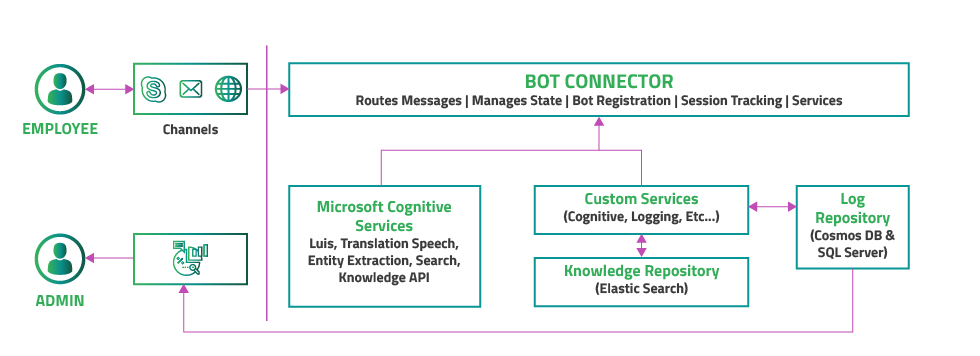Customer Service desks are manned heavily with multiple manual triaging, which results in multiple hops for the customer wherein each step the customer is required to explain the issue from the beginning. Employee IT Helpdesks receives a large volume of service requests via phone calls. The number of such help requests is growing in numbers, thus resulting in a higher delay in providing employee service.
There is a need to efficiently handle these service requests by automatically resolving all the typical user issues and reduce the load on the technical support engineers. A Conversational Bot (Knowledge Bot) is expected to fill in the need by providing quick resolution to the users.
Why
The Artificial Intelligence Chatbots are designed to resolve typical service requests received at the IT Service helpdesks. These Knowledge Bots are expected to reduce the wait time for the customers, and curtail the manual efforts associated. This will help the Support Engineers change their focus from just collecting information and providing simple common solutions to helping the customer tackle with grave and complex issues.
These bots provide special privileges to admin users who can notify the customer with some known system issues or make a global announcement in case there is a network outage or system maintenance in progress. Hence, controlling the heavy volume of ticket flow. The admin interface also provides links to dashboards for reviewing reports on the bot performance and usages, such as the number of requests received daily, weekly or monthly, and those handled by the bot vs. human agent.
FEATURES
Chat Interface:
- Friendly intuitive UI with short-cut menu options for commonly accessed tasks
- UI which displays system notifications or announcements for known issues such as system maintenance or network outage
Conversation Flows:
- Intent and Entity Recognition through LUIS
- Personalized choices and options based on the user’s, user groups or recent nature of global interactions with chat
- Data-Driven conversation flows configurable through YAML files by non-technical users
Knowledge Engine:
- Text Segmentation to extract answers from existing knowledge base articles
- A knowledge engine that is built using word2vec, text semantics, and uses elastic search
Logging & Dashboard:
- Every interaction logged in with all details and metadata created along with the actual conversation
- Reports that describe various aspects of the interaction and savings.
BENEFITS
- Reduction in requests placed through phone calls thereby reducing the number of time agents spending in collecting data rather than solving issue
- Efficient handling of typical user issues by providing self-service steps to resolve, or automatically fixing them by running auto scripts
- Reduction in workload of Service desk personnel relieving them mundane and repetitive tasks which get automated by the bot
- Reduction in wait time for users
- Reduction in time to resolve issues
- Common problems are addressed without manual intervention
- Overall Savings in Service desk cost
- Better interactions and education for users through the knowledge base self-service solutions
Offerings
- Knowledge engine powered Bot for Service desks:
-
A knowledge engine powered Chatbots, which helps automate resolution of issues which would have been handled by IT Helpdesk, thereby reducing significant volumes of helpdesk tickets. The Bot will help users get access to relevant knowledge base articles, raise tickets, check the status of tickets and execute remedial actions based on the understanding of the query through NLP. The Bot would provide a conversational interface and execute the below actions:
- Automatically resolve queries for which a standard solution is available by calling a web service, which will invoke executing scripts.
- Refer to the knowledge repository of past solutions defined to fetch answers to common issues, so that users can try and resolve issues on their own, without the support of help desk engineers.
- Raise tickets or service requests on behalf of the users.
- Allow the user to check the status of the tickets that they have raised.
- Walk through the steps to resolve common technical issues by asking a series of customized questions.
- Provide URLs for users to go to and raise tickets for external systems which are not connected with the Bot.
- For certain urgent situations transfer the users to Human agents for a live chat.
- If the bot is unable to help the user in any of the above manners, the default action is either to provide a canned message with the contact details such as the email address or phone number for the support team.
- The bot would have both the options of menu selections / conversational interface. Irrespective of the user taking either or both of the menu & conversational interfaces the conversational flows are similarly structured.
- Technology Framework
-
- Bot – Azure Bot Service, Application Insights
- Cognitive Services – LUIS, Translation Speech, Entity Extraction, Search,
- Knowledge API
- Database – Azure Cosmos DB, SQL Database, Elastic Search
- ML – Machine Learning Experimentation
- Compute – Virtual Machines, Storage
- Visual Studio Team Services
- AI & ML Framework
-
- Search Engine & Document Indexing
- Topic Modeling (LDA)
- Text Classification
- Lexical Semantics
- Word2Vec
- Synonymy, Ambiguity, Similarity
- Taxonomy Building
- Pattern Mining
- Ngrams
- Parser
- Dependency Relations
- Phrase Extraction
- Question Answering
- Intent / Entity Recognition













